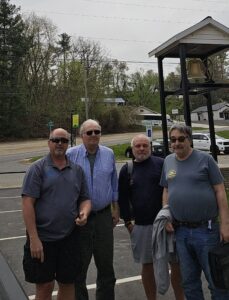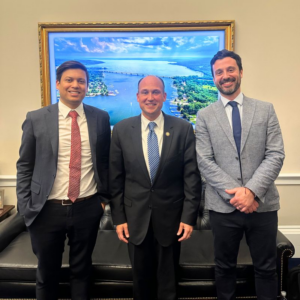Area Students Learn About Plessy V. Ferguson Case
- Jackson 1.jpg cutline: From left Greg Peterson, Robert H. Jackson Center co-founder, Phoebe Ferguson, and Keith Plessy talk about the landmark Supreme Court case “Plessy V. Ferguson. P-J photos by Michael Zabrodsky
- Jackson.jpg Cutline: Area students and educators listen to a presentation Tuesday about “Plessy v. Ferguson — From Vs to &: A Living Legacy” at the Robert H. Jackson Center.

Jackson 1.jpg cutline: From left Greg Peterson, Robert H. Jackson Center co-founder, Phoebe Ferguson, and Keith Plessy talk about the landmark Supreme Court case “Plessy V. Ferguson. P-J photos by Michael Zabrodsky
Area students got a chance Tuesday to hear interesting anecdotes about “Plessy V. Ferguson” from the descendants from the original case participants.
As part of Constitution Day at The Robert H. Jackson Center the “Plessy v. Ferguson — From Vs to &: A Living Legacy” presentation was held where Phoebe Ferguson and Keith Plessy gave detailed information about the case.
Greg Peterson, Jackson Center co-founder, moderated the conversation.

“Plessy v. Ferguson” was a landmark Supreme Court case in 1896 that determined racial segregation was not in violation of the United States Constitution as long as facilities were considered “separate but equal.” The case was later overruled by “Brown v. Board of Education” in 1954, which declared that racial segregation was not constitutional.
“The importance is Rober H. Jackson Center recognizing this is an event commemorating Constitution Day,” he said. “If you didn’t have “Plessy v. Ferguson,” you would not have “Brown v. Board of Education,” the most important Supreme Court case there is,” Peterson said, explaining how important Constitution Day is to the center.

Jackson.jpg Cutline: Area students and educators listen to a presentation Tuesday about “Plessy v. Ferguson — From Vs to &: A Living Legacy” at the Robert H. Jackson Center.
According to Keith Plessy, Homer Plessy was born March 17, 1863.
“I have his birth certificate,” Keith Plessy said.
“So everybody says 1862. … They always say it’s in ’62. And it’s on the tombstone. So it’s really wrong. But 1863 — according to his birth certificate — (he was) born in New Orleans,” Keith Plessy added.
Keith Plessy said his upbringing in New Orleans was during the Reconstruction Era.
“So he was able to attend the same schools as white children. He was able to marry a white woman if he chose. He was a free person of color, from his lineage, and it is, I would say, his DNA. In 1790, his great grandfather’s maternal great grandfather was white, and he married a free woman of color. They had children. In the 1860s, his maternal grandfather was fighting for civil rights. And in 1870s, his stepfather, because his father died when he was very young, his stepfather was fighting for civil rights. So he (Homer Plessy) was exposed to it. So it was in his DNA to fight for his freedom when his rights were being taken away,” Keith Plessy said.
Ferguson noted that the case had origins centered around the Separate Car Act of 1890 which required separate but equal train car accomodations for Blacks and whites.
“I’m here to learn (more) about the case they are talking about,” said Alaina Whittington, an 11th-grade student at Frewsburg Central School.
Peterson said Chautauqua County has a close connection with the debate on segregation. The attorney who represented Plessy came from Mayville, and Robert H. Jackson served as a Supreme Court justice when the case was overruled.








